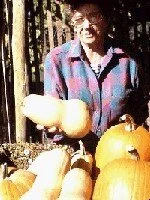by Michael Hofferber. Copyright © 1994. All rights reserved.
It was the final day of the season for the Fallins' roadside produce stand and Mae Fallin was ready to close up.
For three months Mae and her husband, Vern, had stood behind their tables of melons and corn and apples and squash. Thousands of their homegrown tomatoes and watermelon and peppers passed through their hands this long, hot summer, sold to customers from Boise and Twin Falls and Pocatello and even New York.
"The customers from New York were a nice little family," Mae recalled. "They had been to Alaska and were heading home taking the back roads when they saw our stand."
Located just west of the Bliss exit off of Interstate 84 in southern Idaho, the Fallins' produce stand has become an institution in its six years on the site. Many tourists stop in to buy a few apples or a crenshaw, but an increasing percentage of the stand's customers are regulars, people who return year after year for dependable quality and reasonable prices.
"A lot of people have been telling us that we've got to come back next year because they need us," Mae said with a chuckle. "They're very appreciative."
Mae is 67 years old, however, and Vern is 74. They know there's a limit to how long they can continue planting, weeding, picking, hauling and selling their own produce. But they need to stay busy, Mae said, and the extra income is always welcome.
"It makes it worthwhile if you can get a few bucks ahead and buy a refrigerator or something," Mae pointed out. "Last year we barely got the bank paid off."
This year's harvest was more fruitful, though, thanks to an especially warm summer.
The Fallins grow their melons on leased ground in the Hagerman Valley, about 30 miles away. They look for pastures or last year's alfalfa ground with gravity-feed irrigation. A sandy loam soil is best. The heavy-feeding melons can grow on the same ground for two years at most, then the Fallins must find another plot. And good ground for growing melons is getting hard to find, according to Mae.
The secret to growing good melons, aside from the soil conditions, is limiting their water intake. Too many gardeners and growers over-water, she said. "Give them a drink and then turn off the water real quick," she advised.
One of their specialties is a hybrid cantaloupe variety called Gallicum. A cross between a honeydew and a cantaloupe, the green-meated fruit holds up better in storage and has a rich honeydew flavor. They sell it for 25 cents a pound.
The Fallins are very careful about the quality of the produce they take to their stand. Only the best melons and corn and tomatoes are exposed to the public. And only rarely do they sell produce by other growers.
"This year we bought some watermelon out of Hermiston, Oregon, so we'd have some when we opened July 15. Ours were ready by the first week of August," Mae explained.
The Fallins rent space on a vacant lot near a truck stop for their produce stand. They built a long pole-barn structure with roofing made from cardboard boxes and chicken wire, and beginning in mid-July they take up residence in a little trailer parked alongside.
By mid-October most of the produce has been sold and only a few pumpkins and squash remain. The first frost of the autumn season anticipates another migration. The Fallins are anxious to return home.
"I'm ready for a long soak in a hot bath," Mae admitted.


